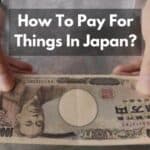Here’s a list of Japanese historical periods that can help you understand the cultures of modern Japan! We traced the Japanese period’s history timeline through the years. Read on to find out!
From ancient hunter-gatherers to modern megacities, Japan boasts a rich and fascinating history. Explore 15 key periods, journeying from the Jomon era’s pottery wonders to the samurai-filled Edo period and the modernization of the Meiji era.
Uncover the defining moments that shaped the Japan of today.
Page Contents
Important Japanese Time Periods In History
Jomon Period (14,000 BCE to around 300 BCE)
The Jomon Period is one of the earliest periods of Japanese history, dating from approximately 14,000 BCE to around 300 BCE.

It is named after the “Jomon” pottery style that was prevalent during this time. The Jomon Period is divided into several phases, each characterized by distinct cultural and technological developments.
This period spanned from around 13,000 BC to 1,000 BC. At the beginning, Japan was home to mostly hunters, gatherers, and fishers.
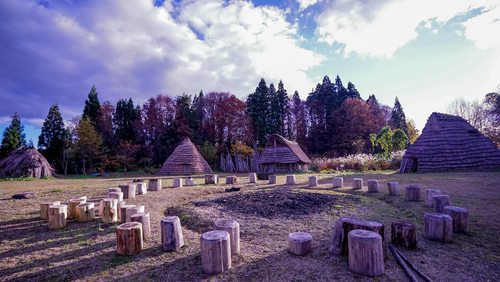
In 1877, Edward S. Morse, an American scholar named this period as Jomon, meaning “cord-marked”. This was in reference to the pottery that the hunter-gatherers decorated with cords made of rope on wet clay. Jomon pottery has been accepted to be some of the oldest in East Asia and the world.
Some popular Shintoism creation myths suggest that the Japanese Imperial Family was founded during the Jomon period.
Key characteristics of the Jomon Period:
- Hunter-Gatherer Lifestyle: The Jomon people were primarily hunter-gatherers who relied on fishing, hunting, and gathering wild plants for their sustenance. They lived in small, semi-nomadic communities and had a deep connection with the natural environment.
- Jomon Pottery: One of the most notable aspects of this period is the pottery created by the Jomon people. Jomon pottery is known for its distinctive cord-marked patterns, created by impressing cords or ropes into the clay before firing. The pottery served various purposes, including cooking, storage, and ritual use.
- Simple Tools and Crafts: The Jomon people made various tools and crafts from natural materials such as stone, bone, antler, and shells. They created stone tools for cutting, scraping, and hunting, and used bone and antler for crafting items like needles and awls.
- Spiritual and Ritual Practices: The Jomon people likely had animistic beliefs, meaning they believed that spirits inhabited natural objects and phenomena. This is suggested by the presence of various ritual artifacts and burial practices, which indicate a reverence for the deceased and spiritual practices related to nature.
- Earliest Settlements: During the later stages of the Jomon Period, some communities began to settle in more permanent locations and develop more sedentary lifestyles. This shift might have been influenced by the development of agriculture in neighboring regions.
- Long Duration: The Jomon Period is one of the longest prehistoric periods in Japanese history, lasting for over 12,000 years. As a result, there were significant regional variations in the Jomon culture across the Japanese archipelago.
- Transition to the Yayoi Period: Around 300 BCE, the Jomon Period transitioned into the Yayoi Period as agricultural practices and rice cultivation were introduced to Japan from the Korean Peninsula. This marked the beginning of a new era characterized by social and technological changes.
Despite its ancient origins, the Jomon Period laid the foundation for many aspects of Japanese culture that continue to this day.
The Jomon people’s close relationship with nature and their artistic expressions through pottery have left a lasting impact on Japan’s cultural identity.
Archaeological discoveries from this period have provided valuable insights into the early history and development of human societies in the Japanese archipelago.
Yayoi Period (300 BCE to around 300 CE)
The Yayoi Period is a significant era in Japanese history that followed the Jomon Period. It is dated from around 300 BCE to around 300 CE.
The period is named after the Yayoi district in Tokyo, where distinctive pottery and artifacts from this time were first discovered.
The Yayoi Period marked a major cultural and technological transition in Japan, with the introduction of wet rice cultivation and its impact on society.
Besides witnessing much agricultural development, there was quite a bit of weapon and tool import to Korea and China. There was also unembellished pottery found in a district of modern day Tokyo that dates back to this period.
During the analysis of Yayoi remains found in Southern Japan, many similarities were found with remains found in Jiangsu, China. This gave rise to the belief that the yayoi people immigrated from China.

The population of Japan began to increase during this time rapidly. The Yayoi tribes eventually came together to form a number of kingdoms.
Key characteristics of the Yayoi Period:
- Introduction of Agriculture: One of the most significant developments during the Yayoi Period was the introduction of wet rice cultivation to Japan. Agricultural practices were brought to the Japanese archipelago from the Korean Peninsula, and the cultivation of rice quickly became a dominant form of farming. The shift from a hunter-gatherer lifestyle to settled agriculture had profound effects on the social and economic structure of ancient Japanese society.
- Yayoi Pottery: The Yayoi people produced distinct pottery that differed from the cord-marked Jomon pottery. Yayoi pottery was made using a wheel and was characterized by more refined and simple designs, often adorned with patterns or ridges. This pottery style was better suited for the storage and preparation of rice.
- Emergence of Social Complexity: With the adoption of agriculture, communities became more settled and started to form larger, organized settlements. The development of agriculture led to surplus food production, allowing for the growth of population and specialization of labor. As a result, social hierarchies began to emerge, and leadership roles became more defined.
- Increase in Technological Advancements: The Yayoi Period saw advancements in metalworking techniques, particularly in bronze and iron. The production of metal tools and weapons played a crucial role in agricultural practices and warfare.
- Interaction with the Korean Peninsula and China: During the Yayoi Period, there was increased cultural exchange with neighboring regions, particularly the Korean Peninsula and China. This exchange influenced various aspects of Japanese society, including language, writing systems, and religious beliefs.
- Shifting Burial Practices: The burial practices during the Yayoi Period underwent changes compared to the Jomon Period. Rather than large burial mounds, smaller burial mounds and pit burials were more common, indicating evolving funerary practices and social structures.
- Transition to a More Complex Society: Towards the later stages of the Yayoi Period, regional chiefdoms emerged, indicating a higher level of political organization. The chiefdoms were characterized by powerful leaders overseeing communities, trade networks, and religious activities.
The Yayoi Period laid the foundation for the subsequent development of Japanese civilization. The introduction of agriculture, establishment of settled communities, and technological advancements played a pivotal role in shaping the course of Japanese history.
It was during this period that many of the cultural and social elements that define Japan today began to take root and evolve.
Kofun Period (300 CE to 538 CE)
The Kofun Period is an important era in Japanese history that follows the Yayoi Period and is dated from approximately 300 CE to 538 CE.
It is named after the large burial mounds called “kofun” that were constructed during this period for members of the ruling elite.
The Kofun Period is characterized by the emergence of centralized political power, the establishment of early kingdoms, and an increasing influence of continental Asian cultures.
Yamato in the Kinai region of central Japan was the center of the unified state. The rulers of the Yamato state were a hereditary line of emperors.
They extended their power all through Japan through military conquest but preferred to convince local authority to exchange power roles for influential posts in the government.
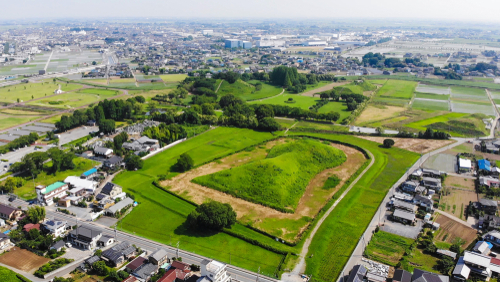
Key characteristics of the Kofun Period:
- Kofun Burial Mounds: The construction of large burial mounds for powerful leaders and members of the elite was a defining feature of this period. The kofun mounds varied in size, with some of the largest being several hundred meters long. These burial sites contained various artifacts, including bronze mirrors, clay haniwa figurines, and other valuable items.
- Political Centralization: The Kofun Period saw the consolidation of political power in the hands of powerful clans. The Yamato clan, centered in the Yamato region (present-day Nara Prefecture), gradually emerged as the dominant ruling clan. They established a system of centralized authority that laid the foundation for the later imperial system.
- Influence of Chinese and Korean Cultures: During this period, there was a significant cultural exchange with China and Korea. Diplomatic missions, trade, and cultural interactions led to the introduction of Chinese writing, Confucianism, Buddhism, and other continental influences.
- Haniwa Figures: Haniwa are clay figurines that were placed on the top of kofun burial mounds. These figurines depicted various human and animal forms and were believed to serve ritual and protective functions for the deceased.
- Technological Advancements: The Kofun Period witnessed further advancements in metalworking and pottery. Bronze mirrors, iron tools, and improved ceramics were produced and used extensively during this time.
- Shifting Religious Beliefs: The adoption of Buddhism and Confucianism from China led to a transformation in religious beliefs and practices in Japan. Alongside these foreign influences, indigenous Shinto beliefs continued to play a significant role in the spiritual life of the people.
- Decline of Kofun Culture: Towards the end of the Kofun Period, the construction of large kofun burial mounds began to decline. This might have been due to economic and social changes, as well as a shift towards smaller, more modest burial practices.
- Transition to the Asuka Period: The Kofun Period came to an end with the establishment of the Asuka Period in 538 CE, which was marked by increased political and cultural influence from China and Korea, as well as the formal recognition of Buddhism as a state religion.
The Kofun Period laid the groundwork for the subsequent development of Japan’s imperial system and the blending of native Japanese traditions with continental influences.
It was a formative period in Japanese history, shaping the nation’s political structure and cultural identity.
The legacy of the kofun burial mounds, haniwa figurines, and the Yamato clan’s rise to power remains an important part of Japan’s historical narrative.
Asuka Period (538 CE to 710 CE)
The Asuka Period is an important era in Japanese history that follows the Kofun Period and is dated from approximately 538 CE to 710 CE.
It is named after the region of Asuka in Nara Prefecture, where the first permanent capital of Japan was established during this time.
The Asuka Period marked a period of significant cultural, political, and religious changes, with strong influences from China and the Korean Peninsula.
The Buddhist Soga clan began controlling Japan from behind the scenes.
Prince Shotoku is known to have played a big role in promoting Chinese ideas. He came up with the seventeen-article constitution. This was a code of conduct for citizens and officials that was inspired by Confucianism.
In 645, the Soga clan was overthrown in a coup launched by Prince Naka no Ōe and Fujiwara no Kamatari, the founder of the Fujiwara clan.
The aim of the reform was to bring great centralization and enhance the power of the imperial court.
After the Jinshin War, the reforms changed and created the ritsuryo state, which is a system of Chinese-style centralized government. This stayed in place for around five hundred years.
Buddhism was a prominent theme for the art from this period. One of the most famous works from this period is the Buddhist temple of Horyu-ji which was commissioned by Prince Shotoku.
Key characteristics of the Asuka Period:
- Introduction of Buddhism: One of the most significant developments during the Asuka Period was the formal introduction of Buddhism to Japan. Buddhism was officially adopted as the state religion in 594 CE under the reign of Emperor Sushun, after earlier attempts to introduce the religion during the Kofun Period. The spread of Buddhism had a profound impact on Japanese culture, art, and religious practices.
- Establishment of a Centralized Imperial Government: The Asuka Period saw the establishment of a more centralized imperial government. The Taika Reforms, implemented in 645 CE, aimed to centralize political power, reform landownership, and create a more bureaucratic administration. This marked a shift away from the decentralized rule of powerful clans during the Kofun Period.
- Influence of Chinese Culture: The Asuka Period was characterized by strong cultural exchanges with China. Chinese political systems, writing, art, and architecture had a significant impact on Japan during this time. Many Japanese students and officials traveled to China to study its culture and administrative methods.
- Asuka Art and Architecture: Asuka art and architecture were heavily influenced by Chinese and Korean styles. Temples and pagodas were constructed in the Chinese architectural style, and art forms such as sculptures and paintings showed clear Chinese influence.
- Shotoku Taishi and the Seventeen-Article Constitution: Prince Shotoku Taishi, a key figure in Japanese history, played a pivotal role in promoting Buddhism and fostering cultural ties with China. He is credited with drafting the “Seventeen-Article Constitution,” a set of ethical and moral guidelines for government officials, emphasizing Confucian principles and Buddhist ideals.
- Influx of Chinese and Korean Scholars: During the Asuka Period, many Chinese and Korean scholars, artists, and craftsmen came to Japan, contributing to the spread of knowledge and expertise in various fields, including medicine, law, astronomy, and art.
- Shift of the Capital: The Asuka Period saw the establishment of multiple capital cities in different locations. The first permanent capital was Asuka, followed by the transfer of the capital to Fujiwara-kyo in 694 CE. This capital was later moved to Heijo-kyo (present-day Nara) in 710 CE, marking the beginning of the Nara Period.
The Asuka Period was a time of transformation and cultural exchange that laid the groundwork for the subsequent development of Japanese civilization.
The influence of Buddhism and Chinese culture during this period played a crucial role in shaping Japan’s religious, political, and artistic landscape.
The Asuka Period is considered a crucial bridge between the ancient traditions of Japan and the more sophisticated cultural and political systems that emerged in the subsequent Nara Period.
Nara Period (710 CE to 794 CE)
The Nara Period is a significant era in Japanese history that followed the Asuka Period and is dated from 710 CE to 794 CE. It is named after the city of Nara, which served as the capital of Japan during this time.
The Nara Period is characterized by the establishment of a strong centralized imperial government, the introduction of Chinese-inspired political and cultural systems, and the flourishing of arts and literature.
In 710, the first permanent Japanese capital was established in Nara. It was during this period that the first two books produced in Japan appeared- Kojiki and Nihon Shoki. These books contained accounts of Japan and myths revolving around its creation.
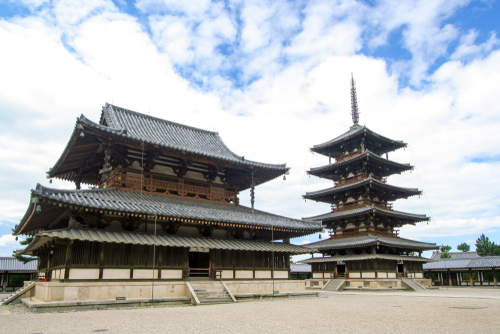
Japan fell victim to many natural disasters during this period, including disease, drought, wildfires, and famines. The Japanese nation experienced a decline in population that continued into the next period.
There was a very serious attempt to overthrow the Imperial house. Monk Dokyo, with the help of Empress Shotoku, tried to establish his own dynasty but couldn’t after her death.
Key characteristics of the Nara Period:
- Capital Relocation: In 710 CE, the capital was moved from Fujiwara-kyo to Heijo-kyo (present-day Nara) following the transfer of the imperial court to Nara. This relocation marked the beginning of the Nara Period and the establishment of a more permanent capital city.
- Ritsuryo System: The Nara Period saw the full implementation of the Ritsuryo system, a legal and administrative system based on Chinese models. The system established a centralized government with a powerful emperor at its center, supported by a hierarchy of officials and bureaucrats. The Ritsuryo system was instrumental in unifying and governing the country.
- Buddhism and Temples: Buddhism continued to play a significant role in Japanese society during the Nara Period. Large Buddhist temples, such as Todai-ji and Kofuku-ji, were constructed in Nara and became centers of religious and cultural activities.
- Nara Art and Architecture: The Nara Period is known for its distinctive art and architecture influenced by Chinese and Korean styles. Temples and pagodas were constructed on a grand scale, featuring intricate wooden structures and statues.
- Compilation of Historical Records: Emperor Tenmu and Empress Jito initiated the compilation of historical records, resulting in the creation of “Kojiki” (Records of Ancient Matters) in 712 CE and “Nihon Shoki” (The Chronicles of Japan) in 720 CE. These texts provided a detailed account of Japan’s mythical and early historical periods.
- The Growth of Japanese Literature: The Nara Period saw the flourishing of Japanese literature, with the composition of many classical works. Notable examples include “Man’yoshu,” a poetry anthology, and “Kojiki,” which played an essential role in preserving early Japanese mythology and history.
- Decline of Centralized Authority: Toward the end of the Nara Period, the central government’s authority began to weaken due to political factionalism and conflicts among powerful aristocratic families. This marked the beginning of the transition to the subsequent Heian Period.
- Fujiwara Clan’s Rise to Power: During the Nara Period, the Fujiwara clan emerged as a prominent political force, with members marrying into the imperial family and holding significant influence over the throne. This familial connection allowed the Fujiwara to control key government positions.
The Nara Period was a time of cultural and political achievements, marked by the establishment of a centralized government and the promotion of Buddhism and Chinese-inspired culture.
It laid the groundwork for the Heian Period that followed, which saw further cultural developments and the emergence of the imperial court as a center of art, literature, and refined courtly culture.
Heian Period (794 CE to 1185 CE)
The Heian Period is a significant era in Japanese history that followed the Nara Period and is dated from 794 CE to 1185 CE. It is named after the city of Heian-kyo, which is present-day Kyoto and served as the capital of Japan during this time.
The Heian Period is known for its flourishing art, literature, and courtly culture, as well as the rise of a distinct Japanese aesthetic and sense of identity.
Spanning from 794 to 1185, the Heian period saw the capital being moved to modern Kyoto. A smallpox epidemic broke out in 812, killing almost half of Japan’s population.
The Imperial court declined through this period. The Fujiwara family controlled the political scene over several centuries by intermarriages with the Imperial family.
The 12th century saw the rise of two aristocratic families to power. They were Minamoto (or Genji) and Taira (or Heike). After the Heiji Rising of 1159, Taira Kiyomori emerged as the leader of Japan. After the death of Kiyomori, the Taira and Minamoto clans fought the Gempei War for supremacy. Minamoto succeeded and established a new government in his home town.
During this period, literary accomplishments included the poetry collection Kokinshu and the Tosa Diary. There was a rise in the development of native Japanese art forms and poetry.
Key characteristics of the Heian Period:
- Relocation of the Capital: In 794 CE, Emperor Kammu moved the capital from Nara to Heian-kyo, which translates to “Capital of Peace and Tranquility.” This relocation marked a shift away from the centralized government of the previous periods, as the Heian court was characterized by aristocratic culture and refined courtly life.
- Fujiwara Clan’s Dominance: The Fujiwara clan, which had gained prominence during the Nara Period, became the most influential political force during the Heian Period. Through strategic marriages with the imperial family, they exercised significant control over the throne and held key government positions.
- Tale of Genji: One of the most celebrated literary works of Japanese literature, “The Tale of Genji,” was written by Murasaki Shikibu, a court lady during the Heian Period. The novel is considered the world’s first full-length novel and provides valuable insights into courtly life and relationships during that time.
- Courtly Culture: The Heian court was known for its elaborate court ceremonies, poetry competitions, and artistic pursuits. Courtiers engaged in the composition of waka poetry (short poems with a specific syllable pattern) and participated in cultural activities, such as calligraphy, painting, and traditional dances.
- Decline of Centralized Authority: Despite the presence of the imperial court, political power during the Heian Period gradually decentralized. The Fujiwara clan’s dominance often led to factionalism and rivalries among aristocratic families, weakening the central government’s authority.
- Rise of Samurai: Towards the end of the Heian Period, Japan experienced increased local conflicts and unrest. This led to the rise of provincial warriors known as samurai, who were initially hired by aristocrats to protect their interests. The emergence of the samurai class would later play a pivotal role in shaping Japan’s future history.
- Emphasis on Aesthetics: Heian culture was characterized by a refined sense of aesthetics, with a focus on beauty, elegance, and courtly manners. The concept of “mono no aware” (the ephemeral nature of things) became central to the Japanese aesthetic sensibility during this time.
- Fujiwara no Michinaga’s Reign: Fujiwara no Michinaga, who was a powerful regent and politician during the late Heian Period, exerted considerable control over the court, virtually ruling in place of the emperor. His reign is considered a peak of Fujiwara clan dominance.
The Heian Period is often regarded as a golden age of Japanese culture, characterized by the splendor and refinement of the aristocratic court. It was a time of artistic creativity, cultural achievement, and the development of a unique Japanese identity.
However, it also marked the beginning of a period of political and social unrest that would lead to significant changes in the subsequent periods, including the rise of the samurai and the transition to the Kamakura Period.
Kamakura Period (1185 CE to 1333 CE)
The Kamakura Period is a crucial era in Japanese history that followed the Heian Period and is dated from 1185 CE to 1333 CE.
It is named after the city of Kamakura, where the Kamakura Shogunate was established, marking a significant shift in political power and the rise of the samurai as a dominant ruling class.
Key characteristics of the Kamakura Period:
- Minamoto no Yoritomo and the Kamakura Shogunate: The Kamakura Period began with the establishment of the Kamakura Shogunate, led by Minamoto no Yoritomo. After the decisive Battle of Dan-no-ura in 1185, Yoritomo emerged as the de facto ruler of Japan, having defeated the rival Taira clan in the Genpei War. He was granted the title of shogun, becoming the first military dictator in Japanese history.
- Decentralization of Power: The Kamakura Shogunate marked a shift away from the centralized rule of the imperial court. The shogunate established its power base in Kamakura, while the emperor remained in Kyoto as a figurehead with symbolic authority.
- Samurai Dominance: The Kamakura Period saw the rise of the samurai as the ruling class in Japan. The samurai were warriors who pledged loyalty to their feudal lords, known as daimyo, in exchange for land and protection. They became the backbone of the shogunate’s military and administrative apparatus.
- Feudal System: The Kamakura Period was characterized by a feudal system, where the shogun and daimyo held significant power over their territories, and the samurai served as warriors and administrators. This decentralized feudal structure allowed local lords to exercise considerable autonomy.
- Mongol Invasions: One of the major events during the Kamakura Period was the attempted invasions by the Mongol Empire in 1274 and 1281. Both invasions were repelled due to a combination of strategic defenses and favorable weather conditions, earning the samurai and the kamikaze (divine wind) a legendary status.
- Zen Buddhism: The Kamakura Period witnessed the widespread adoption of Zen Buddhism, which became influential among the samurai class. Zen teachings emphasized self-discipline, meditation, and a direct, intuitive understanding of enlightenment.
- Internal conflicts and financial difficulties plagued the Kamakura Shogunate in its later years. Additionally, powerful samurai clans, such as the Hojo clan, started to challenge the shogunate’s authority. The period ended with the fall of the Kamakura Shogunate in 1333 CE.
- The Kenmu Restoration: The Kamakura Shogunate was overthrown by Emperor Go-Daigo in 1333, leading to the brief period known as the Kenmu Restoration, during which the emperor attempted to restore imperial power and rule directly. However, the attempt was short-lived, as the Ashikaga Shogunate was established shortly after.
The Kamakura Period was a transformative time in Japanese history, marked by the emergence of a warrior-dominated society and the decline of the imperial court’s political power.
The influence of the Kamakura Shogunate laid the groundwork for the subsequent periods of feudal Japan, where various samurai clans vied for control, leading to further political and social developments in Japanese history.
Muromachi Period (1336 – 1573)
The Muromachi Period is a significant era in Japanese history that followed the Kamakura Period and is dated from 1336 CE to 1573 CE.
It is named after the area of Kyoto known as Muromachi, where the Ashikaga Shogunate established its seat of power. The period is also known as the Ashikaga Period due to the dominant Ashikaga clan’s rule.
Commerce continued to flourish during this period and there was much trade with China and Korea. Some of Japan’s most representative art forms developed. These included ink wash painting, ikebana flower arrangement, tea ceremony, Japanese gardening, bonsai, and Noh theatre.
Towards the end of this period, The Europeans arrived in the country. Francis Xavier and Catholicism reached the shores of Japan in 1559.
Key characteristics of the Muromachi Period:
- Ashikaga Shogunate: The Muromachi Period began with the rise of the Ashikaga Shogunate, led by Ashikaga Takauji. After helping to overthrow the Kamakura Shogunate, Takauji was granted the title of shogun and established a new military government centered in Kyoto.
- Nanboku-cho Period: Early in the Muromachi Period, a period of political division known as the Nanboku-cho Period (1336-1392) occurred. This period saw the split of imperial authority into two rival courts: the Northern Court (based in Kyoto) and the Southern Court (based in Yoshino). The Ashikaga Shogunate initially supported the Southern Court, but later shifted its support to the Northern Court.
- Daimyo and the Ashikaga Shogunate: The Muromachi Period witnessed the strengthening of regional power by local daimyo (feudal lords). Daimyo held significant control over their territories and often had more power than the central government. The Ashikaga shoguns, especially during the later years of the period, struggled to maintain control over the powerful daimyo.
- Zen Buddhism and Cultural Achievements: The Muromachi Period was a time of significant cultural achievements, with Zen Buddhism playing a central role in shaping the arts, including tea ceremonies, flower arranging (ikebana), ink painting (sumi-e), and Noh theater. The arts and cultural refinement of this era are collectively known as the “Higashiyama culture.”
- Onin War: The Onin War (1467-1477) was a major conflict that broke out in Kyoto, resulting in widespread destruction and turmoil. It was a power struggle between competing factions of daimyo and marked the beginning of the Sengoku Period, a time of intense civil wars and territorial disputes.
- Collapse of Central Authority: The Muromachi Period is marked by a gradual decline in the Ashikaga Shogunate’s authority and the inability to maintain control over the daimyo. This decentralization of power led to the weakening of the central government and the rise of regional military leaders.
- The End of the Muromachi Period: The Muromachi Period officially came to an end in 1573 when the Ashikaga Shogunate fell due to internal strife and loss of control. Oda Nobunaga, a powerful daimyo from the neighboring region, played a key role in bringing about the shogunate’s downfall.
The Muromachi Period was a time of cultural flourishing and artistic development in Japan, with Zen Buddhism influencing various aspects of Japanese culture.
However, it was also a time of political turmoil and regional conflict, which set the stage for the subsequent Sengoku Period and the rise of the unified Tokugawa Shogunate in the early modern period of Japanese history.
Azuchi-Momoyama Period (1573 CE to 1603 CE)
The Azuchi-Momoyama Period is a relatively short but significant era in Japanese history that followed the Muromachi Period and is dated from approximately 1573 CE to 1603 CE.
It is named after the two castles that symbolize the period’s beginning and end: Azuchi Castle, built by Oda Nobunaga, and Momoyama Castle, constructed by Toyotomi Hideyoshi.
This period marked the unification of Japan under the leadership of powerful warlords and paved the way for the Tokugawa Shogunate.
Oda Nobunaga was a ruthless warlord who was known for his brilliant strategies. He is known for his string of victories in Japan’s bloodiest civil war. After his abrupt death by ritual suicide, there was apower vaccum created.
Popularly known as the son of a lowly foot soldier, Toyotomi Hideyoshi was a shrewd and resourceful person. He came to be known as medieval Japan’s most powerful warlord. His stronghold, Osaka Castle remains as one of the country’s symbols.
The most devious of the lot, Tokugawa was appointed the chief advisor of Hideyoshi’s young heir. He became the ultimate victor of this period after the Battle of Sekigahara.
This period saw the art of tea flourishing. Nobunaga and Hideyoshi were enthusiastic collectors of tea ceremony utensils.
Key characteristics of the Azuchi-Momoyama Period:
- Oda Nobunaga’s Rise to Power: The Azuchi-Momoyama Period began with the rise of Oda Nobunaga, one of Japan’s most influential warlords. Nobunaga sought to unify Japan under his rule and initiated a series of military campaigns to achieve this goal. He was known for his innovative military strategies and use of firearms.
- Unification of Japan: Oda Nobunaga and his successor, Toyotomi Hideyoshi, continued the process of unifying Japan that was set in motion during the Sengoku Period. Nobunaga made significant strides in this direction, and Hideyoshi completed the task after Nobunaga’s death. The unification ended the era of constant civil wars and brought a semblance of stability to the country.
- Castle Building: During the Azuchi-Momoyama Period, there was a significant development in castle architecture. Oda Nobunaga built Azuchi Castle, which became a symbol of his power and authority. Toyotomi Hideyoshi later constructed Momoyama Castle as a grand fortress.
- Siege of Odawara: Toyotomi Hideyoshi’s last major military campaign was the Siege of Odawara in 1590. After successfully capturing the Hojo clan’s stronghold, Hideyoshi solidified his control over the Kanto region, further consolidating his power.
- Taiko’s Land Survey and Sword Hunt: Toyotomi Hideyoshi implemented land surveys and conducted a “sword hunt,” in which he confiscated weapons from the common people to disarm potential opponents and reinforce centralized rule.
- Cultural Flourishing: The Azuchi-Momoyama Period was a time of cultural growth and refinement. The tea ceremony and Noh theater, which were favored by the ruling elite, became popular during this era. Art and crafts also thrived, with a blend of traditional Japanese aesthetics and influences from foreign cultures, such as China and Korea.
- Toyotomi Hideyoshi’s Rule: After Oda Nobunaga’s assassination, Toyotomi Hideyoshi emerged as the dominant figure in Japan and was effectively the ruler of the country. Although he did not take the title of shogun, he held the highest political authority and was often referred to as “Taiko,” meaning “Great Lord.”
- Transition to the Tokugawa Shogunate: The Azuchi-Momoyama Period ended in 1603 with the establishment of the Tokugawa Shogunate by Tokugawa Ieyasu, who was a former ally of Toyotomi Hideyoshi. Tokugawa Ieyasu secured power by winning the decisive Battle of Sekigahara in 1600 and became the de facto ruler of Japan.
The Azuchi-Momoyama Period laid the groundwork for the subsequent Tokugawa Shogunate, which marked a period of relative peace and isolation from the outside world.
The unification of Japan under Oda Nobunaga and Toyotomi Hideyoshi brought an end to the era of civil wars and set the stage for Japan’s early modern period.
Edo Period (1603 CE to 1868 CE)
The Edo Period, also known as the Tokugawa Period, is a crucial era in Japanese history that followed the Azuchi-Momoyama Period and is dated from 1603 CE to 1868 CE.
It is named after the city of Edo, which is present-day Tokyo, where the Tokugawa Shogunate established its government.
The Edo Period is known for its long-lasting peace, political stability, and the establishment of a unique socio-political system in Japan.
Also known as the Tokugawa Shogunate, this period was during the pre modern centuries when Japan was under the de facto rule of Tokugawa Shoguns.
Although the laws were harsh and brutal, the country enjoyed peace and saw economic growth. Japanese art forms like Kabuki flourished.
With the arrival of the Black Ships and American Commodore Matthew C. Perry, Japan realized how backwards they were when compared to the West.
Key characteristics of the Edo Period:
- Tokugawa Shogunate: The Edo Period began with the rise of the Tokugawa Shogunate under the leadership of Tokugawa Ieyasu. After winning the decisive Battle of Sekigahara in 1600, Ieyasu emerged as the dominant figure in Japan and became the de facto ruler. He was granted the title of shogun in 1603, and his descendants ruled Japan for over 250 years.
- Sankin-kotai: One of the central policies of the Edo Period was the Sankin-kotai system, which required daimyo (feudal lords) to alternate their residence between their domain and the shogun’s court in Edo. This system was designed to control the daimyo and prevent them from amassing too much power.
- Isolationist Policy: During the Edo Period, Japan adopted a policy of national isolation known as “sakoku.” The shogunate restricted foreign influence and limited foreign trade to a few designated ports. This isolation was intended to prevent the spread of Christianity and protect Japan from outside influence.
- Economic Growth and Urbanization: Despite its isolationist policy, the Edo Period saw significant economic growth and urbanization. Edo, the shogun’s capital, became one of the largest cities in the world, while other cities and towns prospered as well.
- Edo Culture: The Edo Period was a time of cultural growth and development. With a stable society and increasing wealth, the common people began to enjoy various forms of entertainment, including kabuki theater, ukiyo-e (woodblock prints), and literature. The culture of the common people became known as “Edo culture.”
- Neo-Confucianism and Education: Neo-Confucianism became the dominant intellectual and moral philosophy during the Edo Period. It influenced education, government policies, and social ethics. Education was promoted for samurai and commoners alike, leading to increased literacy rates.
- Status-Based Society: The Edo Period was characterized by a rigid social structure. Society was divided into four main classes: samurai, farmers, artisans, and merchants. Each class had distinct roles and responsibilities, and social mobility was restricted.
- Decline and Opening of Japan: By the mid-19th century, the Edo Period started facing challenges, including economic difficulties and pressure from Western powers to open Japan to trade. In 1853, Commodore Matthew Perry of the United States arrived with a fleet of warships, demanding that Japan open its ports for trade. This eventually led to the decline of the shogunate and the restoration of imperial rule in 1868.
The Edo Period is considered a time of peace and stability in Japanese history, characterized by strict isolation from the outside world. While the society was structured with clear class distinctions, it also saw cultural and artistic developments that shaped Japan’s unique identity.
The end of the Edo Period and the subsequent Meiji Restoration marked a turning point in Japanese history, leading to modernization, industrialization, and a shift towards a more globalized nation.
Meiji Restoration
The Meiji Restoration is a pivotal event in Japanese history that occurred from 1868 to 1912. It marks the end of the Edo Period and the restoration of imperial rule under Emperor Meiji. The
Meiji Restoration resulted in profound political, social, and economic changes, and it laid the foundation for modern Japan.
Following the Boshin War, Emperor Meiji was restored to nominal supreme rule. Under his rule, Japan became a leading international power. Japan came to be known as one of the Great Powers of the world.
There was also a rise of State Shintoism. Here Shinti rites were used to endorse radical nationalism.
Key events and characteristics of the Meiji Restoration:
- Overthrow of the Tokugawa Shogunate: In the mid-19th century, Japan faced internal and external pressures. The Tokugawa Shogunate, which had ruled Japan for over 250 years, was facing challenges to its authority and influence. Discontent with the shogunate’s handling of foreign threats and growing economic problems led to calls for reform.
- Arrival of Commodore Matthew Perry: In 1853, Commodore Matthew Perry of the United States arrived in Japan with a fleet of warships, demanding the opening of Japan’s ports to foreign trade. This forced Japan to reconsider its isolationist policy and prompted internal debates about the country’s future direction.
- Rise of the Imperial Supporters: A group of samurai and intellectuals who advocated for the restoration of imperial power gained momentum. They believed that a return to imperial rule would strengthen Japan against foreign threats and lead to much-needed modernization.
- Abolition of the Shogunate: In 1868, the Tokugawa Shogunate voluntarily relinquished power, effectively ending its rule. Emperor Meiji, who was only 15 years old at the time, officially ascended to the throne. However, the real power was vested in the hands of the samurai and leaders who supported the emperor.
- Charter Oath: In April 1868, Emperor Meiji issued the Charter Oath, which outlined the principles and goals of the new government. The five-point oath promised political reforms, freedom of speech, modernization, and an end to privileges based on social status.
- Modernization Reforms: The Meiji government initiated a series of ambitious reforms to modernize Japan and strengthen the nation against foreign encroachment. These reforms included the abolishment of the feudal system, establishment of a constitutional monarchy, creation of a modern centralized government, industrialization, and the modernization of the military and education system.
- Abolition of the Samurai Class: As part of the modernization efforts, the samurai class was abolished in 1871. Samurai were allowed to take up new roles in government, business, or education, and Japan transitioned to a more meritocratic system.
- Westernization and Industrialization: Japan adopted various Western models for governance, law, education, and technology. This included the establishment of a constitutional monarchy in 1889 and the introduction of universal education. Industrialization efforts led to the growth of industries and a modern economy.
- Nationalism and Imperial Expansion: As Japan modernized, it also embraced nationalism and embarked on imperial expansion. The country sought to assert itself as a major power in the region and engaged in territorial acquisitions, including Taiwan, Korea, and parts of China.
The Meiji Restoration brought about unprecedented changes in Japan and transformed it from a feudal society into a modern nation-state.
The restoration of imperial rule and the pursuit of modernization allowed Japan to strengthen itself and emerge as a major world power in the 20th century.
The Meiji Era laid the foundation for Japan’s rapid economic and technological development, setting the stage for its role as a major player on the global stage.
Taisho Period (1912 to 1926)
The Taisho Period is an important era in Japanese history that followed the Meiji Period and is dated from 1912 to 1926. It is named after Emperor Taisho, who reigned during this time.
The Taisho Period is characterized by political and social changes, cultural developments, and the growing influence of democratic ideals in Japan.
Key characteristics of the Taisho Period:
- Political Reforms: The Taisho Period marked a shift towards a more democratic political system. The Meiji Constitution was revised in 1911, and the Imperial Diet (parliament) gained more power, allowing for greater political representation and participation.
- Taisho Democracy: The period was known for the emergence of what was termed “Taisho Democracy.” It represented a more open political climate with increased political activism and freedom of speech. However, the democratic movement faced challenges from conservative forces and military influence.
- Economic Growth and Social Changes: The Taisho Period was a time of economic growth, urbanization, and social changes. The country experienced a period of relative stability, allowing for the expansion of the middle class and improvements in education and healthcare.
- Cultural Developments: The Taisho Period saw significant cultural developments in literature, art, and entertainment. Japanese literature flourished with the works of influential authors such as Natsume Soseki and Akutagawa Ryunosuke. Western influences were evident in literature and art during this time.
- Impact of World War I: The Taisho Period saw the impact of World War I on Japan. Although Japan was an ally of the Entente Powers, its role in the war was limited. However, the war created economic opportunities for Japan and further industrial growth.
- Expansion of the Empire: Japan’s territorial ambitions continued during the Taisho Period. The country acquired territories in the Pacific region, including the South Pacific Mandate, following its participation in World War I.
- Political Turmoil and Assassinations: The Taisho Period also witnessed political turmoil and assassinations. In 1921, Prime Minister Hara Takashi was assassinated, and several other politicians were targeted during this time.
- Emperor Taisho’s Illness: Emperor Taisho suffered from a severe mental illness, which affected his ability to govern. As a result, a regency was established in 1921, and his son, Emperor Hirohito (Emperor Showa), eventually assumed the throne after Taisho’s death in 1926.
The Taisho Period was a time of transition and change in Japan. The country continued to modernize and adapt to new global influences, while also experiencing political challenges and social shifts.
The period laid the groundwork for the subsequent Showa Period, which witnessed significant political and military developments leading up to World War II.
Showa Period (1926 to 1989)
The Showa Period is a significant era in Japanese history that followed the Taisho Period and is dated from 1926 to 1989.
It is named after Emperor Showa, whose reign spanned the entire period. The Showa Period is marked by dramatic political, social, and economic changes, including Japan’s involvement in World War II and its subsequent recovery and transformation into a modern industrialized nation.
Key characteristics of the Showa Period:
- Emperor Showa’s Reign: Emperor Showa, also known as Emperor Hirohito, ascended to the throne in 1926 after the death of his father, Emperor Taisho. His reign lasted until 1989, making it the longest in Japanese history.
- Economic Turmoil and the Great Depression: The early years of the Showa Period were marked by economic turmoil, exacerbated by the Great Depression that began in 1929. Japan faced severe economic challenges, including high unemployment and financial instability.
- Militarization and Expansionism: During the 1930s, Japan became increasingly militarized and expansionist. The military gained influence in the government, leading to a series of aggressive actions in Asia, including the invasion of Manchuria in 1931 and the full-scale invasion of China in 1937.
- Second Sino-Japanese War: Japan’s invasion of China in 1937 marked the beginning of the Second Sino-Japanese War, which later merged into World War II. The conflict in China further escalated Japan’s militaristic ambitions.
- World War II and Pacific War: Japan’s expansionism culminated in its entry into World War II in 1941, following the attack on Pearl Harbor. Japan’s aggressive military campaigns extended throughout the Asia-Pacific region, leading to significant destruction and loss of life.
- Surrender and Occupation: After the atomic bombings of Hiroshima and Nagasaki in August 1945, Japan surrendered to the Allied forces, officially ending World War II. The country was placed under the occupation of the United States, and General Douglas MacArthur served as Supreme Commander of the Allied Powers (SCAP).
- Post-War Recovery and Economic Miracle: During the post-war period, Japan underwent rapid economic recovery and growth. The country’s remarkable economic development and industrialization earned it the moniker “Japanese Economic Miracle.”
- New Constitution and Democracy: In 1947, Japan adopted a new constitution that included a commitment to pacifism, the establishment of a constitutional monarchy, and the recognition of fundamental human rights. The new constitution became a cornerstone of Japan’s post-war democracy.
- Japan-U.S. Security Alliance: In 1951, Japan signed the Treaty of San Francisco, officially ending the occupation and reestablishing its sovereignty. In 1960, Japan signed a security treaty with the United States, forming a strong security alliance that remains in effect to this day.
- Social Changes: The Showa Period saw significant social changes, including the role of women in society and the growth of urbanization. Japan’s traditional values and customs began to shift with the influence of modernization.
The Showa Period witnessed Japan’s transformation from a militaristic power during World War II to a peaceful and prosperous nation with a strong economy and democratic government.
The period was a time of profound change and rebuilding, and it laid the foundation for Japan’s emergence as a major economic and technological powerhouse in the latter half of the 20th century and beyond.
The Showa Period came to an end with the death of Emperor Showa in 1989, and the era was succeeded by the Heisei Period.
Heisei Period (1989 – 2019)
The Heisei Period is an important era in Japanese history that followed the Showa Period and is dated from 1989 to 2019. It is named after the new era name “Heisei,” which means “Achieving Peace.”
The Heisei Period is marked by significant political, economic, and social changes, as well as various natural disasters and global events.
After the death of Emperor Hirohito, Japan was in a struggle with a stagnant economy, rapidly aging population and strained relations with regional neighbours.
This period is marked by two devastating earthquakes. They are Kobe of 1995 and Tohoku of 2011.
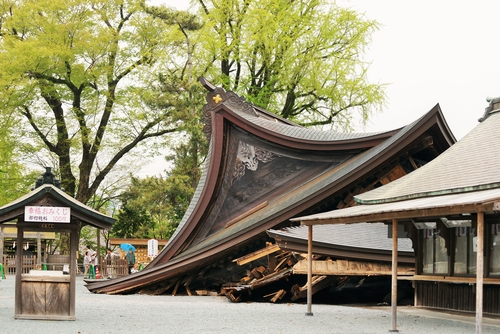
One of the world’s most isolated and underdeveloped nations has now become one of the most powerful nations and a vacation destination for millions.
Key characteristics of the Heisei Period:
- Ascension of Emperor Akihito: The Heisei Period began on January 8, 1989, following the death of Emperor Hirohito (Emperor Showa). His son, Emperor Akihito, ascended to the throne, marking the start of a new imperial era.
- Economic Bubble and Burst: The early years of the Heisei Period saw a continuation of Japan’s rapid economic growth, known as the “bubble economy.” However, the bubble eventually burst in the early 1990s, leading to a prolonged period of economic stagnation and deflation known as the “Lost Decade.”
- Political Changes: The Heisei Period witnessed various political changes and shifts in power. The Liberal Democratic Party (LDP), which had dominated Japanese politics for decades, experienced challenges from opposition parties. Several prime ministers came and went during this period, leading to a degree of political instability.
- Natural Disasters: Japan experienced significant natural disasters during the Heisei Period. In 1995, the Great Hanshin Earthquake struck Kobe, resulting in widespread destruction and loss of life. The country also faced devastating earthquakes, tsunamis, and typhoons throughout the era.
- Akihito’s Abdication: In April 2019, Emperor Akihito announced his intention to abdicate the throne due to his advancing age and declining health. This marked the first imperial abdication in Japan in over two centuries. He was succeeded by his son, Emperor Naruhito, on May 1, 2019.
- Technological Advancements: The Heisei Period was a time of rapid technological advancements and innovation. Japan played a significant role in the development of electronics, robotics, and other cutting-edge technologies.
- Population Aging and Decline: The Heisei Period saw Japan’s population aging at an unprecedented rate and a decline in the birth rate. These demographic challenges posed significant economic and social implications for the country.
- Globalization and Cultural Exchange: During the Heisei Period, Japan continued to engage in globalization and international cultural exchange. The country hosted the 1998 Winter Olympics in Nagano and the 2002 FIFA World Cup in collaboration with South Korea.
- Social Issues and Gender Roles: The era brought attention to various social issues, including the need for gender equality and the advancement of women’s roles in society. Efforts were made to address gender disparities in the workplace and promote work-life balance.
The Heisei Period was a time of both triumphs and challenges for Japan. The country faced economic difficulties, natural disasters, and social issues while also contributing to global technological advancements and cultural exchange.
As Emperor Akihito’s reign came to an end, the Heisei Period concluded with a sense of reflection on the achievements and struggles experienced during those 30 years.
Reiwa Period (2019 – Present)
The Reiwa period is the current era of Japan’s official calendar. It began on 1 May 2019, the day on which Emperor Akihito’s elder son, Naruhito, ascended the throne as the 126th Emperor of Japan.
The day before, Emperor Akihito abdicated the Chrysanthemum Throne, marking the end of the Heisei era.
The name “Reiwa” was chosen by the government and means “beautiful harmony”. It is the first Japanese era name to be taken from Japanese literature instead of classic Chinese literature. The characters “rei” and “wa” are taken from a poem in the Man’yōshū, the oldest anthology of Japanese poetry.
The Reiwa period has seen a number of significant events, including the COVID-19 pandemic and the assassination of former Prime Minister Shinzo Abe.
Despite these challenges, Japan has continued to make progress in areas such as economic growth and technological innovation.
The Reiwa period is still young, but it has already shown great promise. It is a time of great change and opportunity for Japan, and the country is well-positioned to meet the challenges of the 21st century.
Key characteristics of the Reiwa Period:
- Emperor Naruhito’s Reign: Emperor Naruhito ascended to the throne on May 1, 2019, following the abdication of his father, Emperor Akihito. His ascension marked the beginning of the Reiwa Period.
- Continuation of Political and Social Issues: The Reiwa Period continues to see Japan grappling with various political, economic, and social challenges. These include an aging population, declining birth rates, economic stagnation, and gender equality issues.
- Natural Disasters: Japan experienced significant natural disasters during the Reiwa Period, including Typhoon Hagibis in October 2019, which caused extensive damage and loss of life.
- Impact of the COVID-19 Pandemic: Like the rest of the world, Japan faced the challenges of the COVID-19 pandemic during the Reiwa Period. The government implemented measures to contain the spread of the virus, and the pandemic had significant effects on various aspects of society and the economy.
- Cultural Events and Achievements: Despite the challenges posed by natural disasters and the pandemic, Japan continued to host cultural events and showcase its achievements in technology, art, and entertainment during the Reiwa Period.
- Focus on Environmental Issues: The Reiwa Period has seen a growing emphasis on environmental issues and sustainability in Japan, with the government and various organizations working towards a greener and more eco-friendly future.
- Tokyo Olympics and Paralympics: The Reiwa Period was notable for the rescheduling of the Tokyo 2020 Summer Olympics and Paralympics to 2021 due to the COVID-19 pandemic. The event served as an opportunity for Japan to showcase its hosting capabilities and resilience during challenging times.
What is the oldest Japanese period?
The oldest period in Japanese history is the Jomon Period. It is considered the earliest known historical era in Japan and dates back to approximately 14,000 BCE to 300 BCE. The Jomon Period is characterized by its distinct pottery style, which is one of the key archaeological markers used to identify this period.
How many eras did Japan have?
Japan has had a total of 248 eras, including the current Reiwa Period. Each era is marked by the reign of a specific emperor. The Japanese era system is a unique way of counting time that designates a distinct name and period for each imperial reign.
The era names are chosen from classical Chinese literature and often carry symbolic meanings or aspirations for the time of the reign.
When a new emperor ascends to the throne, a new era begins, and the year count is reset to year one of that era. The era names are widely used in official documents, calendars, and historical records.
The first recorded era in Japanese history is the Taika era (645-650 CE), which was proclaimed by Emperor Kotoku.
Since then, era changes have occurred upon the death of an emperor and the ascension of a new one, with a few exceptions, such as the era change due to the abdication of Emperor Akihito in 2019, which marked the beginning of the Reiwa Period.
What are the 5 periods of Japanese history?
The five traditional periods of Japanese history are: Jomon Period (approx. 14,000 BCE to 300 BCE), Yayoi Period (approx. 300 BCE to 300 CE), Kofun Period (approx. 300 CE to 710 CE), Asuka Period (approx. 710 CE to 794 CE), and Nara Period (approx. 710 CE to 794 CE)
What was the most violent period in Japanese history?
The most violent period in Japanese history is generally considered to be the Sengoku Period, also known as the Warring States Period. This era lasted from the late 15th century to the late 16th century, and it was characterized by intense and prolonged civil wars between various feudal lords (daimyo) vying for territorial control and political dominance.
What was the best period in Japanese history?
The Heian period (794-1185) is considered the best period in Japanese history. The capital was moved to Kyoto, and the arts flourished. The Tale of Genji, one of the world’s great novels, was written during this period.
Here are some of the reasons why the Heian period is considered the best period in Japanese history:
- Cultural achievements: The Heian period saw a flowering of Japanese culture, including the development of new forms of poetry, literature, art, and music. The Tale of Genji, written by Murasaki Shikibu, is considered one of the greatest novels ever written.
- Political stability: The Heian period was a time of relative political stability in Japan. The Fujiwara clan dominated the government, but they were able to maintain a balance of power between the imperial court and the military.
- Economic prosperity: The Heian period was a time of economic prosperity in Japan. The country was involved in trade with China and Korea, and there was a growing demand for Japanese goods.
- Social harmony: The Heian period was a time of social harmony in Japan. The class system was rigid, but there was a sense of order and stability in society.
How is Japanese history divided?
Japanese history is divided into a number of periods, each of which is characterized by its own unique political, social, and cultural features. Some of the most commonly used periods in Japanese history include:
- Prehistoric Japan (from the earliest times to 538 AD): This period includes the Jōmon, Yayoi, and Kofun periods.
- Classical Japan (538-1185 AD): This period includes the Asuka, Nara, and Heian periods.
- Feudal Japan (1185-1603 AD): This period includes the Kamakura, Muromachi, and Azuchi-Momoyama periods.
- Early Modern Japan (1603-1868 AD): This period includes the Edo period.
- Modern Japan (1868-present): This period includes the Meiji, Taisho, Showa, and Heisei periods.
- Reiwa period (2019-present): This is the current period in Japanese history.
These periods are not always strictly defined, and there is some overlap between them. However, they provide a general framework for understanding the major developments in Japanese history.
What are the periods in feudal Japan?
The period of feudal Japan is often divided into several key periods, each marked by distinct political, social, and military developments. The main periods in feudal Japan are:
- Kamakura Period (1185-1333)
- Muromachi Period (1336-1573)
- Sengoku Period (late 15th – late 16th century)
- Azuchi-Momoyama Period (1568-1603)
- Edo Period (1603-1868)
What was Middle Ages in Japan called?
The Middle Ages in Japan is commonly referred to as the “Feudal Period” or the “Age of the Samurai.”
This period lasted from the late 12th century to the late 19th century and was characterized by a decentralized political structure, with powerful regional lords (daimyo) holding significant authority and control over their respective territories.
The samurai warrior class played a crucial role during this era, and their loyalty to their daimyo defined the social and military structure of Feudal Japan.
When was Japan’s dark age?
The term “dark age” is often used to describe a period of time when there is a decline in cultural and intellectual activity. In the context of Japanese history, there is no one single period that is universally considered to be a dark age.
However, some historians have argued that the Sengoku period (1467-1603) could be considered a dark age for Japan.
The Sengoku period was a time of great political instability and military conflict. The country was divided into a number of warring states, and there was a great deal of violence and destruction.
The arts and sciences also declined during this period, as people were more focused on survival than on cultural pursuits.
Also Read:




